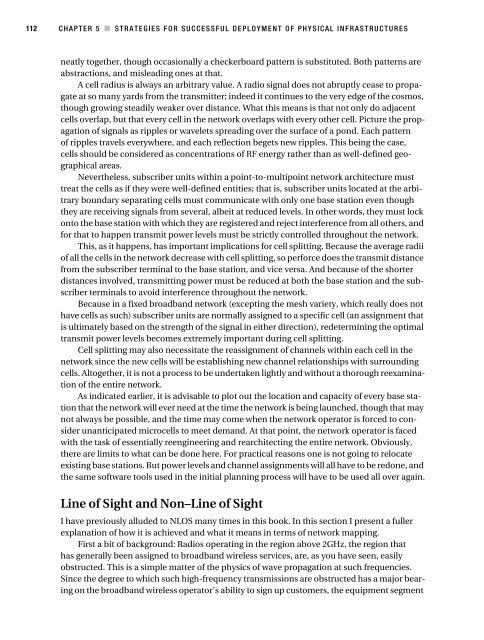WiMax Operator's Manual
WiMax Operator's Manual
WiMax Operator's Manual
Create successful ePaper yourself
Turn your PDF publications into a flip-book with our unique Google optimized e-Paper software.
112 CHAPTER 5 ■ STRATEGIES FOR SUCCESSFUL DEPLOYMENT OF PHYSICAL INFRASTRUCTURES<br />
neatly together, though occasionally a checkerboard pattern is substituted. Both patterns are<br />
abstractions, and misleading ones at that.<br />
A cell radius is always an arbitrary value. A radio signal does not abruptly cease to propagate<br />
at so many yards from the transmitter; indeed it continues to the very edge of the cosmos,<br />
though growing steadily weaker over distance. What this means is that not only do adjacent<br />
cells overlap, but that every cell in the network overlaps with every other cell. Picture the propagation<br />
of signals as ripples or wavelets spreading over the surface of a pond. Each pattern<br />
of ripples travels everywhere, and each reflection begets new ripples. This being the case,<br />
cells should be considered as concentrations of RF energy rather than as well-defined geographical<br />
areas.<br />
Nevertheless, subscriber units within a point-to-multipoint network architecture must<br />
treat the cells as if they were well-defined entities; that is, subscriber units located at the arbitrary<br />
boundary separating cells must communicate with only one base station even though<br />
they are receiving signals from several, albeit at reduced levels. In other words, they must lock<br />
onto the base station with which they are registered and reject interference from all others, and<br />
for that to happen transmit power levels must be strictly controlled throughout the network.<br />
This, as it happens, has important implications for cell splitting. Because the average radii<br />
of all the cells in the network decrease with cell splitting, so perforce does the transmit distance<br />
from the subscriber terminal to the base station, and vice versa. And because of the shorter<br />
distances involved, transmitting power must be reduced at both the base station and the subscriber<br />
terminals to avoid interference throughout the network.<br />
Because in a fixed broadband network (excepting the mesh variety, which really does not<br />
have cells as such) subscriber units are normally assigned to a specific cell (an assignment that<br />
is ultimately based on the strength of the signal in either direction), redetermining the optimal<br />
transmit power levels becomes extremely important during cell splitting.<br />
Cell splitting may also necessitate the reassignment of channels within each cell in the<br />
network since the new cells will be establishing new channel relationships with surrounding<br />
cells. Altogether, it is not a process to be undertaken lightly and without a thorough reexamination<br />
of the entire network.<br />
As indicated earlier, it is advisable to plot out the location and capacity of every base station<br />
that the network will ever need at the time the network is being launched, though that may<br />
not always be possible, and the time may come when the network operator is forced to consider<br />
unanticipated microcells to meet demand. At that point, the network operator is faced<br />
with the task of essentially reengineering and rearchitecting the entire network. Obviously,<br />
there are limits to what can be done here. For practical reasons one is not going to relocate<br />
existing base stations. But power levels and channel assignments will all have to be redone, and<br />
the same software tools used in the initial planning process will have to be used all over again.<br />
Line of Sight and Non–Line of Sight<br />
I have previously alluded to NLOS many times in this book. In this section I present a fuller<br />
explanation of how it is achieved and what it means in terms of network mapping.<br />
First a bit of background: Radios operating in the region above 2GHz, the region that<br />
has generally been assigned to broadband wireless services, are, as you have seen, easily<br />
obstructed. This is a simple matter of the physics of wave propagation at such frequencies.<br />
Since the degree to which such high-frequency transmissions are obstructed has a major bearing<br />
on the broadband wireless operator’s ability to sign up customers, the equipment segment
















